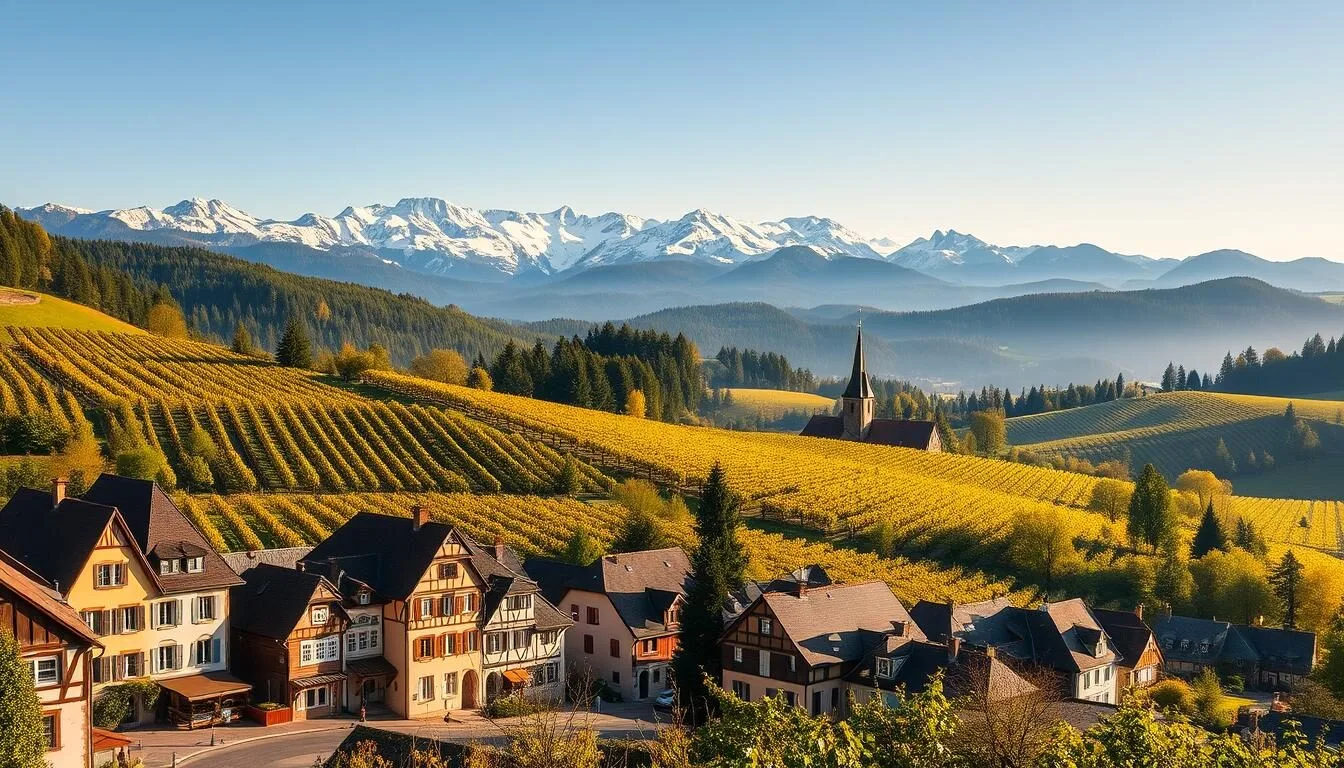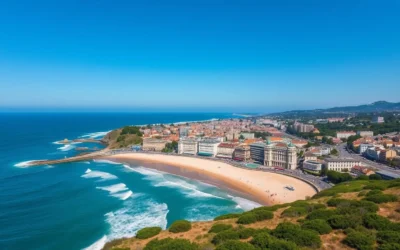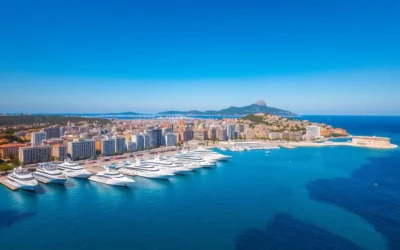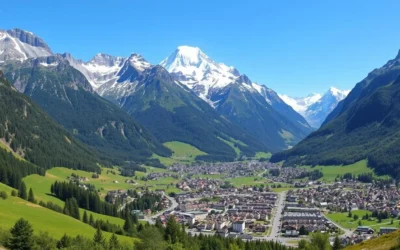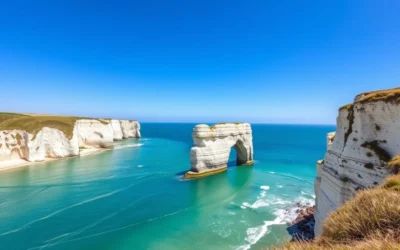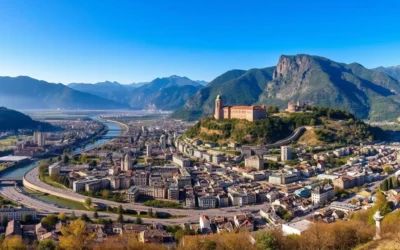✓ Accommodations✓ Flights✓ Rental Cars
Imagine strolling through fairytale towns and picturesque vineyards in a region that seamlessly blends French and German influences. Welcome to Alsace, a unique destination in northeastern France that promises an unforgettable experience.
As you visit Alsace, you’ll be captivated by its exceptional wines, particularly the white varieties like Riesling and Gewürztraminer. The region is also home to vibrant cities like Strasbourg and Colmar, a scenic wine route, and the breathtaking Vosges Mountains, offering a wide range of activities for every type of traveler.
Whether you’re interested in history, gastronomy, outdoor adventures, or cultural experiences, Alsace has something for everyone. This guide will help you discover the top attractions and experiences that make Alsace a standout destination in France.
Discovering the Charm of Alsace
Nestled in the heart of Europe, Alsace offers a unique blend of French and German influences. This distinctive cultural fusion is evident in its architecture, cuisine, and traditions, making Alsace a fascinating region to visit.
The Unique French-German Blend
Alsace’s strategic location has made it a crossroads of cultures. The region’s history as a borderland between France and Germany has resulted in a rich cultural heritage. You can experience this blend in the local cuisine, which combines French sophistication with German heartiness, and in the architectural styles that range from half-timbered houses to grand cathedrals.
Geography and Landscape
The Alsace region boasts a diverse landscape, from the fertile Rhine Valley to the rolling hills covered with vineyards and the majestic Vosges Mountains. The geography has significantly influenced the development of the region, particularly its wine production. The east-facing slopes receive optimal sunlight, making Alsace renowned for its high-quality wines. The picturesque landscape, with its patchwork of vineyards, forests, and charming villages, offers a serene and idyllic setting for visitors to visit Alsace.
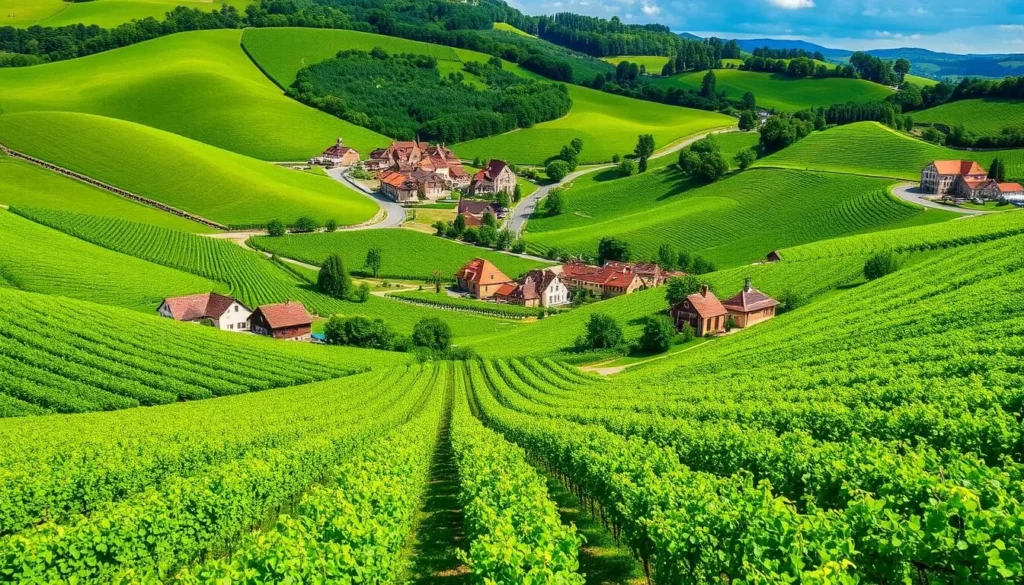
Exploring Strasbourg: The Capital of Alsace
Exploring Strasbourg is an essential part of any trip to Alsace. As the capital city, Strasbourg offers a unique blend of French and German cultures, making it a fascinating destination.
Strasbourg Cathedral: A Gothic Masterpiece
The Strasbourg Cathedral is a breathtaking example of Gothic architecture, with intricate details and a majestic presence. You can climb to the top for panoramic views of the city.
Grande Île and La Petite France
La Petite France, located on the Grande Île, is a charming district known for its half-timbered houses, canals, and cobblestone streets. You can explore this picturesque area on foot, discovering its unique charm.
River Ill Boat Tours
The River Ill is the lifeblood of Strasbourg, encircling the Grande Île and creating the city’s distinctive waterways. You can take a boat tour to explore the city from a different perspective. Options range from traditional guided cruises to self-piloted electric boats. You can rent a small electric boat from Marin d’Eau Douce in La Petite France and explore at your own pace.
Wandering Through Colmar’s Fairytale Streets
Visiting Colmar is like stepping into a fairytale, with its cobblestone streets and vibrant culture. This charming town in Alsace, France, is a must-visit destination, especially during the winter season when it transforms into one of Europe’s most enchanting Christmas market destinations.
Little Venice (Petite Venise)
Little Venice, or Petite Venise, is a picturesque area in Colmar with charming canals and beautifully restored houses. It’s a perfect spot to enjoy the town’s charm, especially during the Christmas season.
Old Town Museums and Architecture
Colmar’s Old Town is filled with unique architecture and museums that showcase the town’s rich history and culture. Visitors can explore the cobblestone streets and discover the many historic buildings and museums.
Colmar During Christmas Season
During the Christmas season, Colmar becomes a winter wonderland, with six different Christmas markets spread throughout the Old Town, each with its own theme and specialty products. Visitors can enjoy traditional Alsatian Christmas foods and drinks, such as bredele and hot mulled wine, and experience the magical atmosphere created by the spectacular decorations and illuminations.
To make the most of your visit to Colmar, consider visiting on weekday mornings when the markets are less crowded. Be sure to explore the children’s Christmas market in Petite Venise, complete with a vintage carousel and Santa’s mailbox. Additionally, enjoy the other winter activities in Colmar, including concerts in historic churches and special exhibitions at the museums.
Alsace, France: Best Things to Do – Top Picks for Wine Lovers
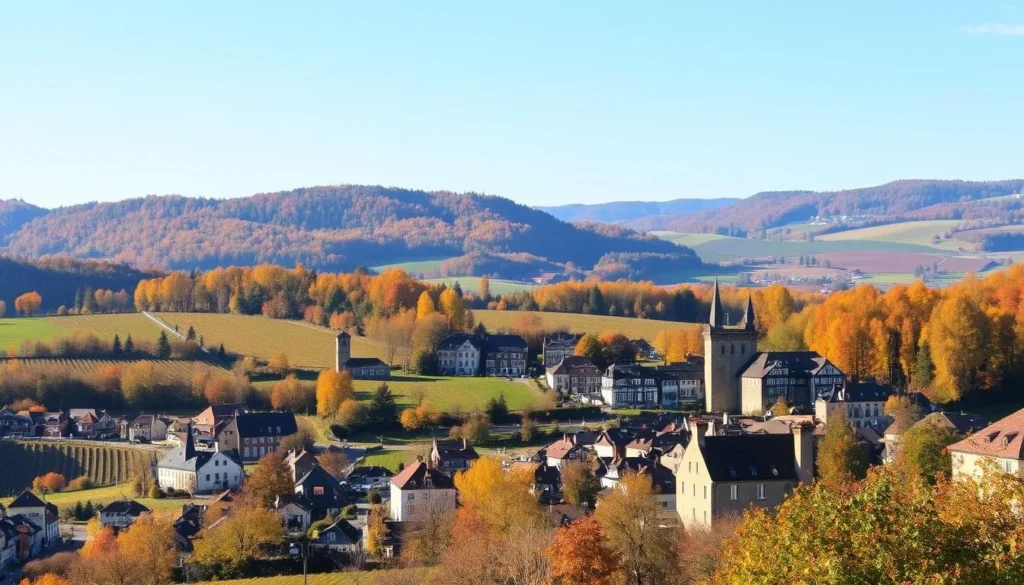
Alsace, France, is a paradise for wine lovers, offering an array of wine-related experiences. The region is renowned for its Alsace wine route, a scenic journey through picturesque vineyards and charming villages.
The Route des Vins d’Alsace
The Route des Vins d’Alsace is a 170-kilometer route that winds through the heart of the Alsace wine region. This scenic drive takes you through some of the most beautiful vineyards in France, with numerous stops at local wineries and charming villages along the way. As you explore the route, you’ll discover the rich history and culture of Alsace wine production.
Wine Tastings at Local Vineyards
One of the highlights of visiting Alsace is the opportunity to taste some of the region’s exceptional wines at local vineyards. Many wineries offer wine tastings, allowing you to sample a variety of wines, from crisp Riesling to rich Gewürztraminer. Be sure to visit some of the region’s top vineyards to experience the best of Alsace wine.
Cycling Through the Vineyards
For a more leisurely experience, consider cycling through the vineyards on your bike. The Alsace wine region has an extensive network of cycling paths, making it easy to explore the area at your own pace. You can rent a bike in one of the many local towns and enjoy the scenic views of the surrounding vineyards as you ride along the dedicated véloroute du vignoble d’Alsace.
Visiting the Most Picturesque Villages
Alsace is renowned for its picturesque villages, each offering a unique glimpse into the region’s rich history and culture. You can visit these charming places to experience the authentic Alsatian way of life.
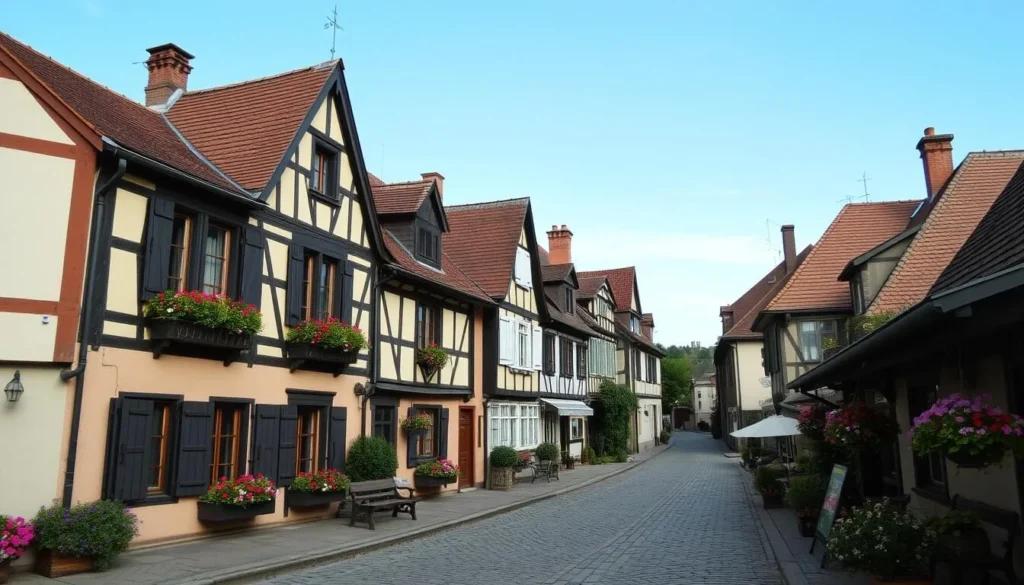
Riquewihr and Ribeauvillé
Riquewihr and Ribeauvillé are two of Alsace’s most famous villages. Riquewihr is known for its well-preserved medieval architecture, while Ribeauvillé boasts stunning Renaissance buildings. You can visit these villages to admire their unique charm.
Eguisheim and Kaysersberg
Eguisheim is a charming town with a rich history, featuring cobblestone streets and colorful houses. Kaysersberg, on the other hand, is famous for its medieval fortifications and picturesque vineyards. Visiting these villages allows you to explore the region’s diverse cultural heritage.
Bergheim and Hunspach
Bergheim is one of Alsace’s best-preserved walled villages, offering a more authentic experience. You can explore its medieval ramparts and enjoy the quiet atmosphere. Hunspach, located in northern Alsace, is known for its distinctive black and white half-timbered houses, providing a glimpse into a different aspect of Alsatian culture.
These villages provide a contrast to the more visited locations, offering a more relaxed pace and authentic local experiences. By visiting these charming villages, you can truly immerse yourself in the beauty and culture of Alsace.
Exploring Medieval Castles and Fortifications
The rolling hills of Alsace hide some of Europe’s most fascinating medieval castles, waiting to be explored. These castles not only reflect the region’s rich history but also offer breathtaking views and unique experiences.
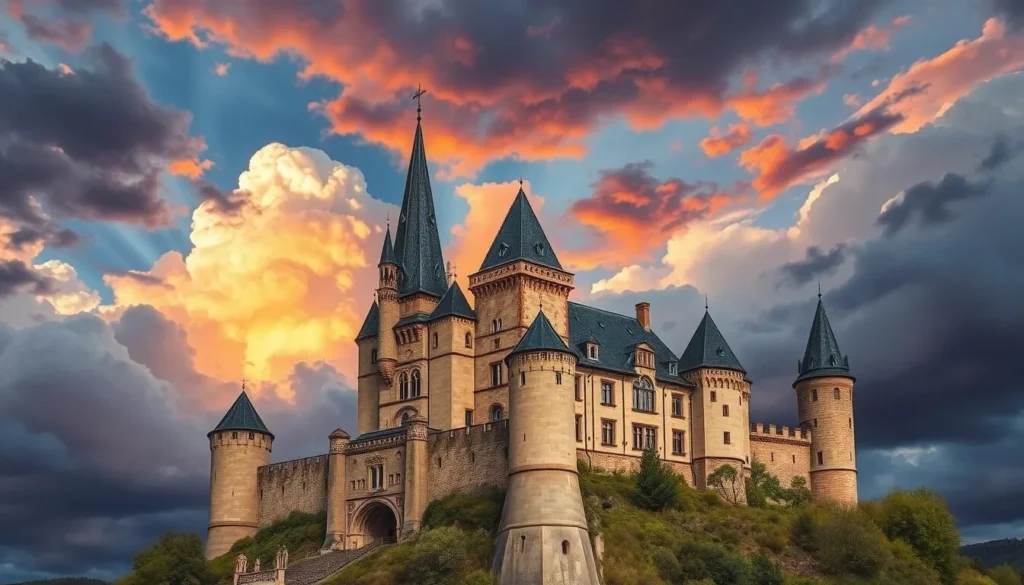
Château du Haut-Koenigsbourg
Perched atop a rocky outcrop, Château du Haut-Koenigsbourg is one of Alsace’s most iconic medieval castles. This 12th-century fortress has been meticulously restored and now serves as a museum, offering insights into the lives of its former inhabitants. As you visit the castle, you’ll be treated to panoramic views of the surrounding countryside.
Château de Fleckenstein
Nestled deep in the Parc Naturel Régional des Vosges du Nord, Château de Fleckenstein is a dramatic rock castle carved directly into a sandstone outcrop. The castle’s unique construction incorporates natural rock formations into its defensive structure, creating a fortress that seems to grow out of the mountain. Visitors can experience the “Castle of Challenges,” an interactive adventure that combines exploration of the castle ruins with medieval-themed puzzles and activities.
As you explore the ruins, you’ll discover a network of passages, stairs, and chambers carved into the rock, showcasing medieval engineering ingenuity. Climbing to the top of the ruins rewards you with panoramic views of the surrounding forests stretching into Germany. Unlike Haut-Koenigsbourg, Fleckenstein offers a more rugged and natural castle experience, focusing on ruins rather than restored grandeur.
Hiking in the Vosges Mountains
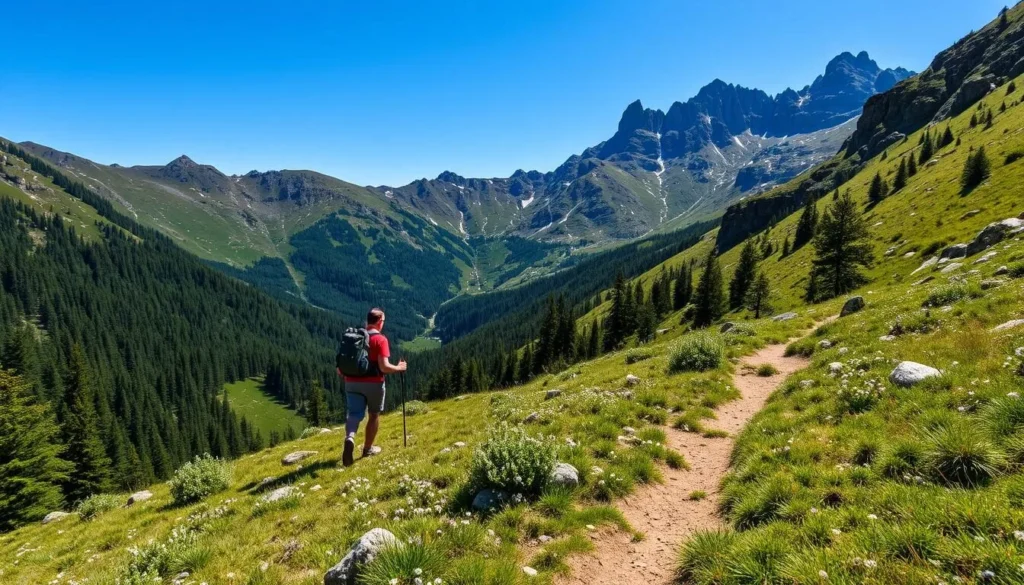
For those seeking adventure beyond Alsace’s wine region, the Vosges Mountains offer a vast and varied hiking landscape. With over 1700 km of trails, you can explore dense forests, high mountain pastures, and rocky summits, all while enjoying the region’s unique blend of natural beauty and cultural heritage.
The Route des Crêtes (Ridge Road)
The Route des Crêtes is a standout feature of the Vosges Mountains, offering breathtaking views and a unique hiking experience. This ridge road is perfect for those who want to explore the higher elevations without the need for strenuous hiking.
Best Hiking Trails and Viewpoints
The Vosges Mountains are home to a diverse range of hiking trails, including the GR5 long-distance trail, the circuit of Lac Blanc, and the path to Château du Hohlandsbourg. Whether you’re interested in waterfall hikes, historical routes, or botanical walks, there’s a trail to suit your interests. Be sure to check out the rock formations of Rocher de Dabo and the panoramic views from Le Grand Ballon for unforgettable vistas.
Outdoor Adventures Beyond Hiking
Beyond hiking, Alsace offers a plethora of outdoor adventures that cater to all interests and ages. The region’s diverse landscape provides a perfect backdrop for a variety of activities.
Cycling Routes and Bike Rentals
Alsace is a cyclist’s dream, with plenty of bike rental options and scenic cycling routes that wind through the picturesque countryside. You can explore the vineyards, villages, and forests on two wheels, enjoying the fresh air and stunning views. Many bike rental companies offer guided tours, making it easy to discover the best routes.
Chemin des Cimes Treetop Walk
For a unique experience, visit the Chemin des Cimes, a treetop walkway that offers an immersive experience in the Vosges forests. The 1,050-meter elevated wooden pathway and 29-meter spiral observation tower provide breathtaking views of the surrounding landscape. With interactive stations along the way, you’ll learn about the forest ecosystem and local wildlife. This activity is accessible to all, including those with mobility limitations, making it an inclusive outdoor adventure. It’s a great experience to have during the summer, but it’s open year-round, offering a different perspective with each season.
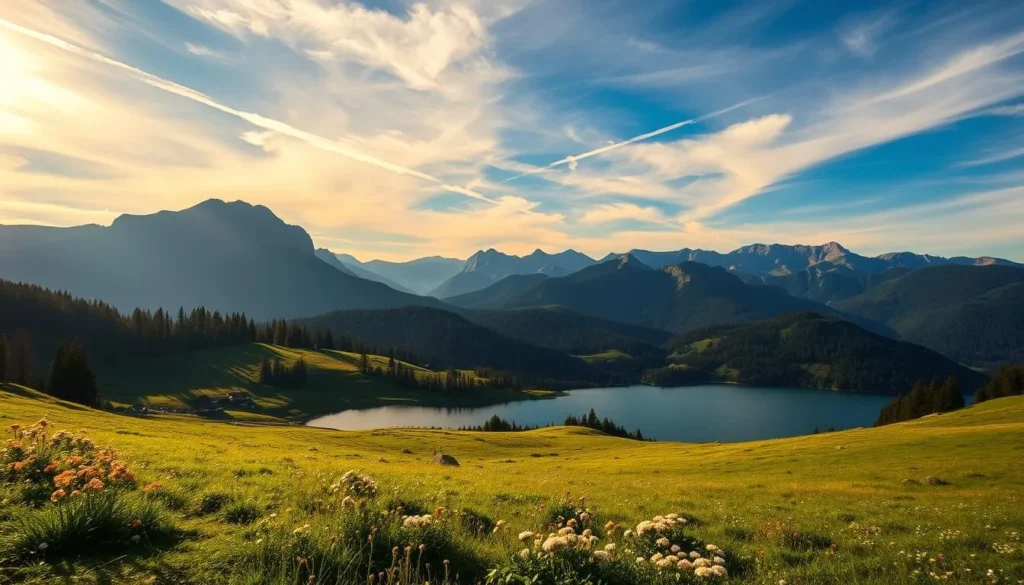
Savoring Alsatian Cuisine
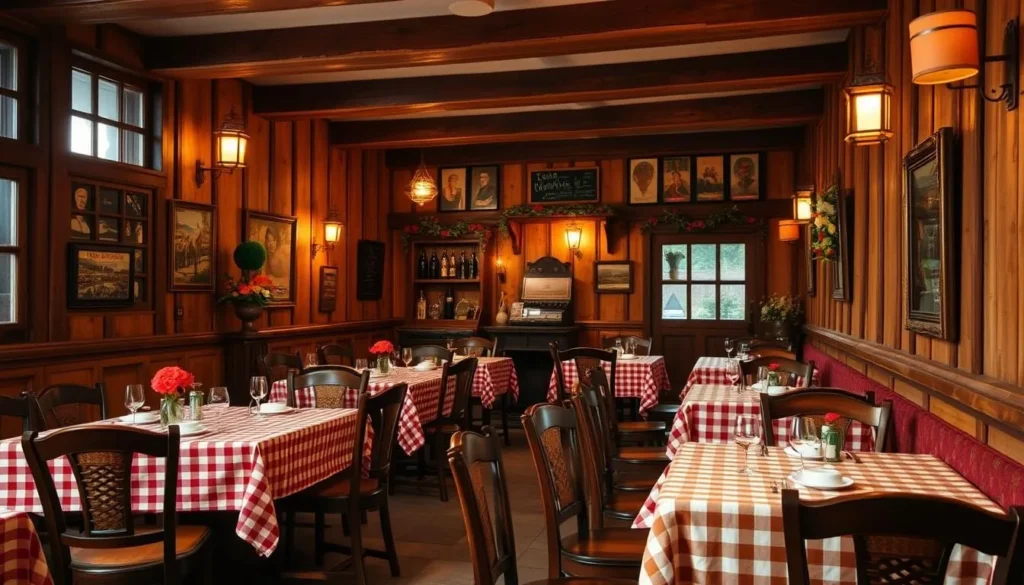
Alsatian cuisine is a delicious reflection of the region’s cultural heritage, combining French sophistication with German heartiness. As you explore the local food scene, you’ll discover a unique blend of flavors and traditions.
Must-Try Traditional Dishes
When dining in Alsace, be sure to try some of the region’s signature dishes, such as Tarte Flambée, a thin crust topped with cream, onions, and bacon, and Baeckeoffe, a hearty meat and potato stew. Don’t forget to sample the local Munster cheese, a strong and creamy delight.
Winstubs: Traditional Alsatian Taverns
A visit to Alsace isn’t complete without dining at a winstub, a traditional tavern that originated as a place where winemakers would serve their new wines alongside simple, hearty food. Characterized by wooden paneling, checkered tablecloths, and communal seating, winstubs offer a warm and convivial atmosphere. Notable winstubs include Winstub Le Clou and S’Burjerstuwel – Chez Yvonne in Strasbourg, and Au Pont Corbeau in Colmar. These cultural institutions preserve traditional Alsatian recipes and dining customs, serving generous portions and house wines in traditional carafes.
Tasting Local Specialties
The Alsatian cuisine is a unique fusion of French and German culinary traditions, waiting to be savored. You’ll find a variety of local specialties that showcase the region‘s rich gastronomic heritage.
Munster Cheese from the Source
Munster cheese, a strong and creamy cheese, originates from the Vosges Mountains. This cheese is typically served with potatoes or bread, and its robust flavor pairs well with local wines. You can visit local farms to taste Munster cheese straight from the source.
Tarte Flambée and Other Regional Delights
Tarte flambée, or flammekueche, is Alsace’s signature dish – a thin-crusted savory tart topped with crème fraîche, onions, and bacon. This dish originated as a baker’s test for oven temperature before baking bread. You can enjoy variations of tarte flambée with mushrooms, cheese, or seasonal ingredients. Other regional delights include kougelhopf, bretzel, and pain d’épices. During summer, be sure to try fresh asparagus and mirabelle plums.
| Local Specialty | Description | Pairing Suggestion |
|---|---|---|
| Tarte Flambée | Thin-crusted savory tart | Local wine |
| Munster Cheese | Strong and creamy cheese | Potatoes or bread |
| Kougelhopf | Crown-shaped brioche | Coffee or wine |

Discovering Alsatian Crafts and Artisans
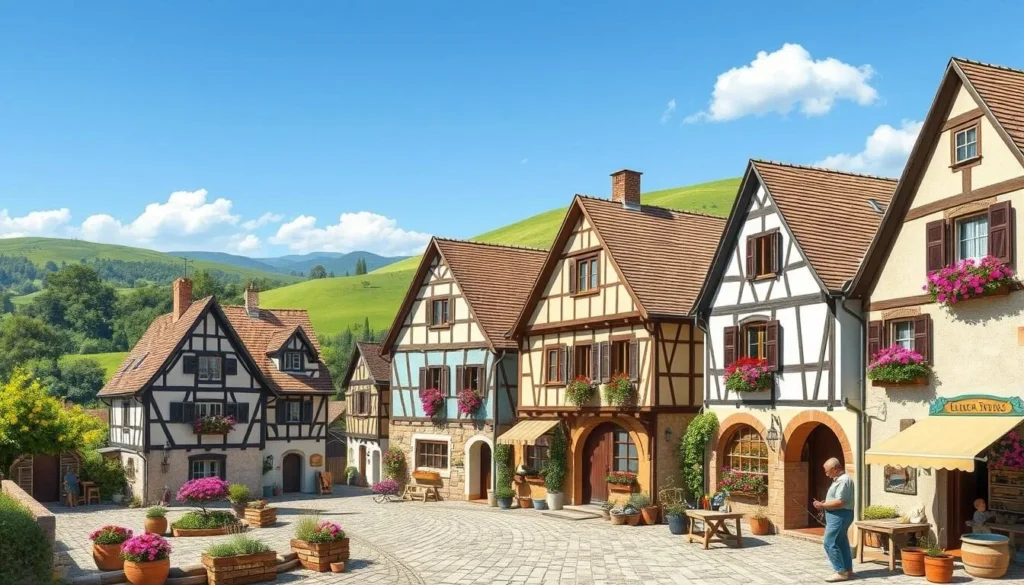
Alsace is renowned for its rich tradition of craftsmanship, offering a unique glimpse into the region’s cultural heritage. The region is home to numerous villages and towns where artisans continue to practice traditional crafts.
Pottery in Betschdorf and Soufflenheim
The villages of Betschdorf and Soufflenheim are particularly famous for their pottery. For centuries, these villages have been producing high-quality earthenware and crockery, with many families still using colorful Soufflenheim pots to cook traditional dishes like choucroute (sauerkraut).
Traditional Crafts and Workshops
Alsace is also known for its diverse traditional crafts, including woodcarving, glass-blowing, textile weaving, and copper work. Visitors can explore numerous workshops and museums to experience these crafts firsthand and purchase handcrafted items directly from the artisans.
Many of these crafts reflect the region’s history and cultural influences, showcasing both French and German heritage. Seasonal craft traditions, such as ornament making for Christmas markets, are also an integral part of Alsatian culture.
Best Time to Visit Alsace
Planning your trip to Alsace requires considering the region’s climate and seasonal events to make the most of your visit. Alsace’s continental climate means you can expect warm summers and cold winters, with relatively low rainfall compared to other parts of France.
Seasonal Highlights and Festivals
Alsace is a year-round destination, with each season offering unique experiences. Spring and fall are ideal for hiking and wine tasting, while summer is perfect for outdoor dining and festivals. If you’re visiting in winter, don’t miss the Christmas markets, especially in Colmar.
- Spring: Enjoy mild weather and blooming vineyards.
- Summer: Experience outdoor festivals and warm evenings.
- Autumn: Savor the harvest season with wine tastings.
- Winter: Visit Christmas markets and enjoy potential snowfall.
Weather Considerations
The Vosges Mountains create a rain shadow effect, giving Alsace one of the driest climates in France. This is beneficial for both tourism and wine production. When planning your visit, consider packing accordingly: light layers for summer evenings and proper winter gear if you’re visiting in December.
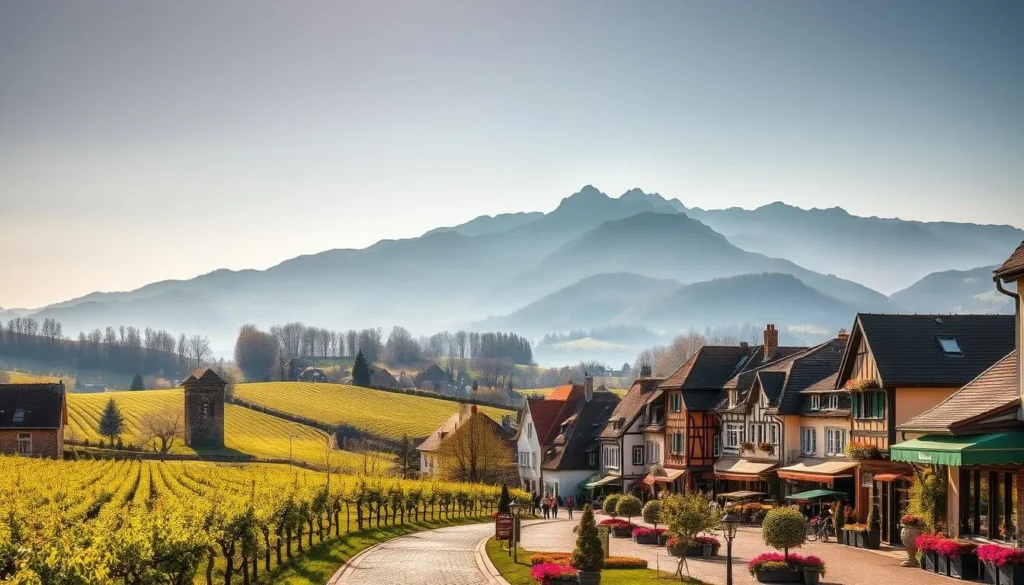
Understanding the weather patterns will help you plan your itinerary, including indoor alternatives on rare rainy days. With its relatively dry and sunny climate, Alsace remains a great destination year-round.
Getting Around Alsace
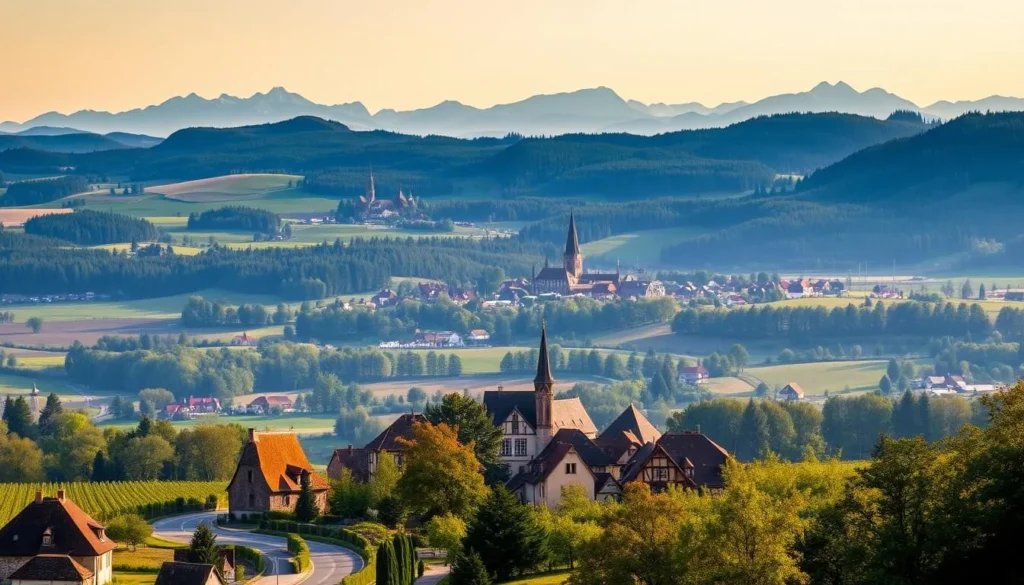
Alsace is easily accessible, with several transportation methods to suit your travel style. The region’s efficient public transportation system and well-maintained roads make it simple to explore its charming villages and vineyards.
Renting a Car vs. Public Transportation
Renting a car provides the freedom to explore Alsace at your own pace, especially along the Alsace wine route. However, public transportation is a convenient alternative, with buses connecting major towns and tourist areas.
Organized Tours and Day Trips
Joining an organized tour can be a great way to experience Alsace, especially if you’re short on time or prefer not to drive. Various tours are available, including wine tastings and visits to picturesque villages, often departing from Strasbourg or Colmar.
Planning Your Itinerary
With so much to see and do in Alsace, creating an itinerary that suits your interests is essential. Whether you’re looking for a quick getaway or a leisurely vacation, Alsace has something for everyone.
3-Day Itinerary in Alsace
A 3-day trip to Alsace can be a great introduction to the region. You can start by arriving in Colmar in the afternoon and spending the evening exploring the town. On the second day, visit Eguisheim, Kaysersberg, Riquewihr, and Ribeauvillé, all known for their picturesque landscapes and wine production along the Alsace wine route. On the third day, explore Dambach-la-Ville, Obernai, Rosheim, and end your day in Strasbourg.
Week-Long Exploration
For a more immersive experience, consider a week-long exploration of Alsace. You can dedicate a day to exploring the northern part of the region, including Strasbourg and the pottery villages. Another day can be spent on the Central Wine Route, visiting Ribeauvillé, Riquewihr, and other charming villages. The Southern Wine Route around Colmar offers plenty of opportunities for wine tastings and exploring surrounding villages. You can also spend a day hiking in the Vosges Mountains or visit the Château du Haut-Koenigsbourg.
| Day | Region | Activities |
|---|---|---|
| Day 1 | Colmar | Explore Colmar, enjoy dinner |
| Day 2-3 | Central Wine Route | Visit Ribeauvillé, Riquewihr, Eguisheim |
| Day 4 | Vosges Mountains | Hiking, visit Château du Haut-Koenigsbourg |
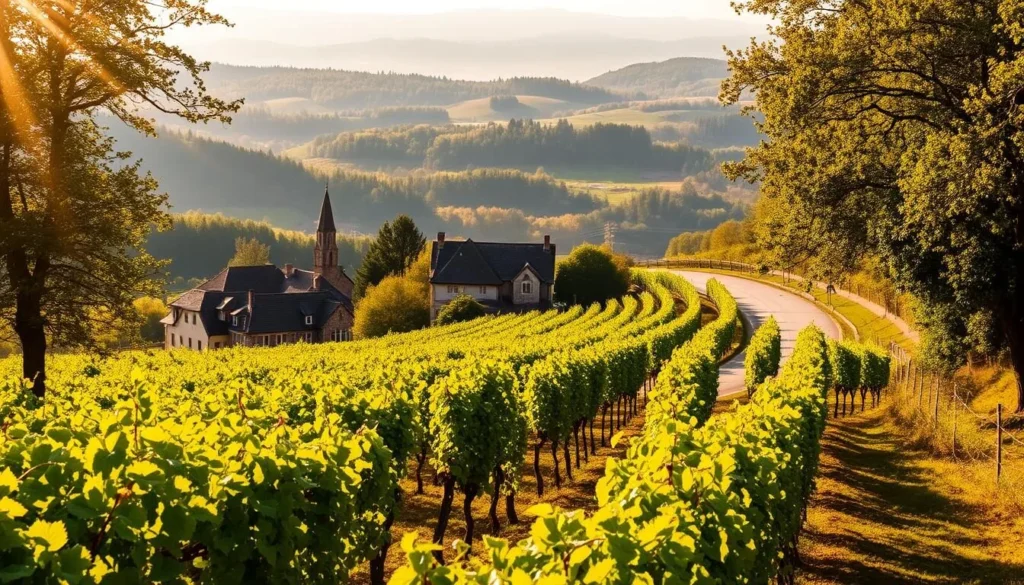
Off-the-Beaten-Path Experiences
For those looking to venture off the beaten path, Alsace presents a unique blend of industrial heritage and rural charm. This region in northeastern France is not just about picturesque villages and vineyards; it has a rich history that spans beyond its medieval architecture and wine production.
The Sundgau Region
The Sundgau region, located in the southern part of Alsace, offers a tranquil and less-explored area characterized by its rolling hills, picturesque villages, and vast agricultural lands. Visitors can enjoy a serene rural experience, exploring the local culture and history. It’s an ideal trip for those seeking a peaceful getaway from the more touristy areas.
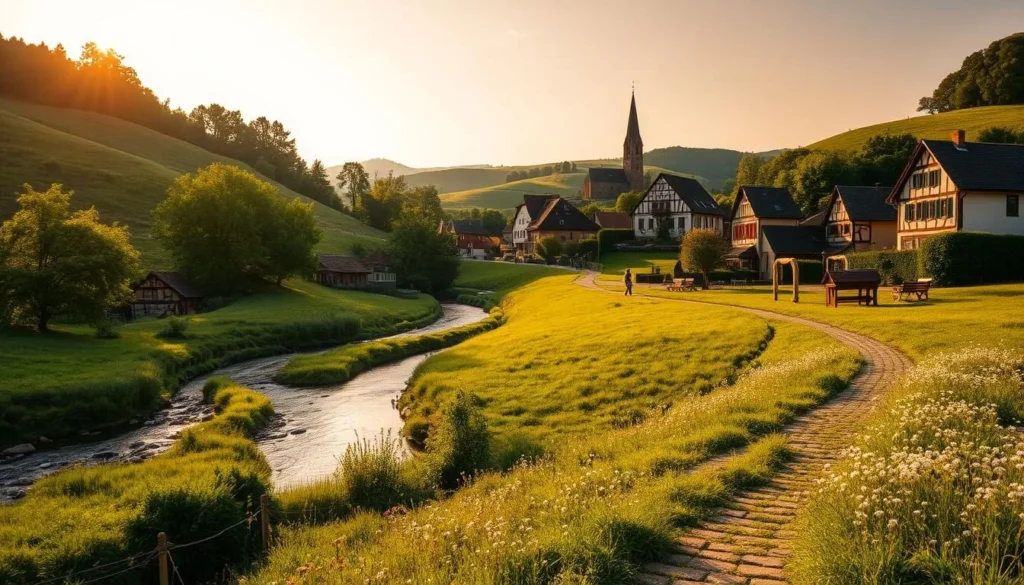
Potash Mines and Industrial Heritage
Alsace’s industrial heritage is another fascinating aspect of the region, particularly around the area north of Mulhouse. The Route de la Potasse (Potash Road) is a notable attraction that showcases the history of potash mining, which operated from 1910 to 2002. Visitors can explore former mining villages like Wittelsheim and Pulversheim, where preserved mine shafts and workers’ housing colonies offer a glimpse into the lives of miners. The Carreau Rodolphe in Pulversheim is a must-visit, a former mine site now turned into an industrial heritage center. This unique aspect of Alsace’s history provides a compelling contrast to its more traditional attractions, making for a diverse and enriching travel experience in the region.
Creating Lasting Memories in Alsace
Nestled in the heart of Europe, Alsace is a region that will captivate your senses and leave you with lasting memories. As you visit Alsace, you’ll discover fairytale villages, world-class wine, and distinctive cuisine. To make the most of your trip, consider combining Alsace with nearby destinations like Paris or Switzerland. Capture memories by participating in wine harvests, cooking classes, or local festivals. Bring home a piece of Alsace with souvenirs like artisanal foods, pottery, or wines. This article has guided you through the best experiences Alsace has to offer.
The above is subject to change.
Check back often to TRAVEL.COM for the latest travel tips and deals.
